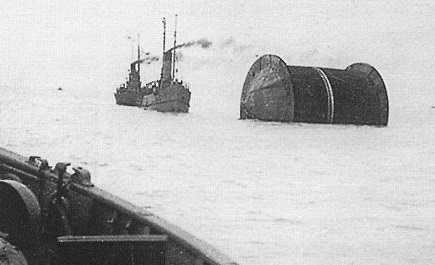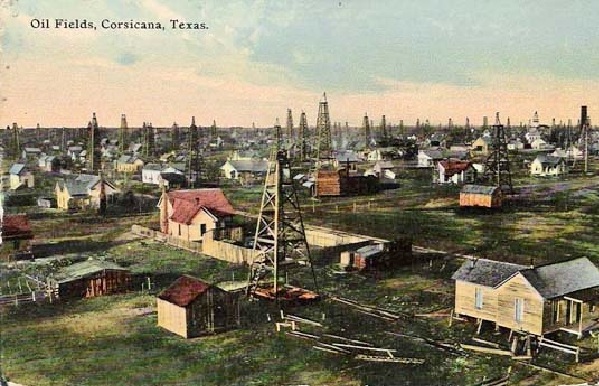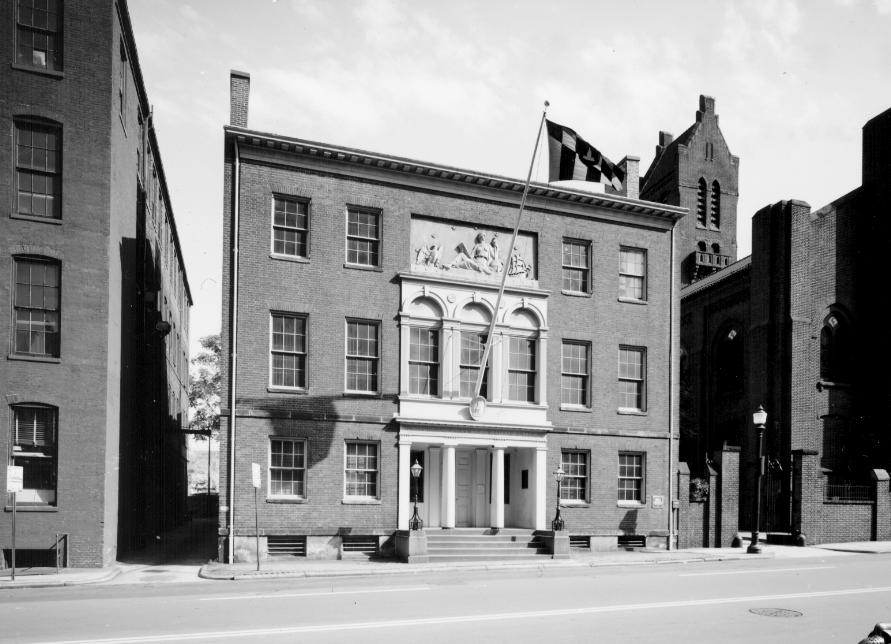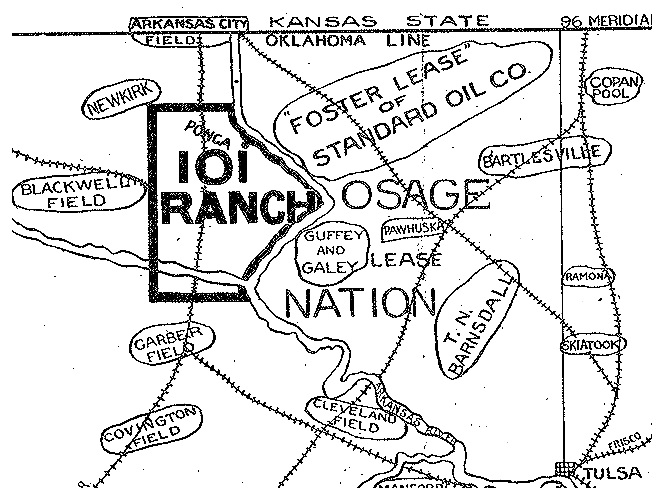June 6, 1932 – First Federal Gasoline Tax –
The federal government taxed gasoline for the first time when the Revenue Act of 1932 added a one-cent per gallon excise tax to U.S. gasoline sales. The first state to tax gasoline had been Oregon, which imposed a one-cent per gallon tax in 1919. Colorado, New Mexico, and other states followed. The federal tax, last raised on October 1, 1993, has remained at 18.4 cents per gallon (24.4 cents per gallon for diesel). About 60 percent of the federal gasoline tax is used for highway and bridge construction.
June 6, 1944 – English Channel Pipelines fuel WWII Victory
As the D-Day invasion began along 50 miles of fortified French coastline in Normandy, logistics for supplying the effort would include two top-secret engineering feats — construction of artificial harbors followed by the laying of pipelines across the English Channel.

Operation PLUTO’s tubing was unspooled to cross the English Channel and help fuel Allied victory in WWII.
Code-named “Mulberrys” and using a design similar to modern jack-up offshore rigs, the artificial harbors used barges with retractable pylons to provide platforms to support floating causeways extending to the beaches.
To fuel the Allied advance into Nazi Germany, Operation PLUTO (Pipe Line Under The Ocean) used flexible steel pipelines wound onto giant “conundrums” designed to spool off when towed. Gen. Dwight Eisenhower later acknowledged the vital importance of the oil pipelines.
Learn more in PLUTO, Secret Pipelines of WW II.
June 6, 1976 – Oil Billionaire J. Paul Getty dies
With a fortune as high as $4 billion, J. Paul Getty died at 83 at his estate near London. Born into his father’s oil wealth from the Oil Company of Tulsa, Getty made his first million in oil leasing by the time he was 23.
“I started in September 1914, to buy leases in the so-called red-beds area of Oklahoma,” Getty told the New York Times. “The surface was red dirt and it was considered impossible there was any oil there. My father and I did not agree and we got many leases for very little money which later turned out to be rich leases.” Getty left more than $661 million of his estate to the J. Paul Getty Museum in Los Angeles.
June 9, 1894 – Water Well finds Oil in Corsicana,, Texas
A contractor hired by the town of Corsicana to drill a water well on 12th Street found oil instead, launching the Texas petroleum industry seven years before the more famous discovery at Spindletop Hill, 230 miles southeast.
Drilled with cable-tools, Corsicana’s first oil well produced just 2.5 barrels of oil a day from 1,035 feet deep. It nevertheless brought a rush of exploration companies, and by 1898 there were about 300 oil wells around the boom town, which became a center for technological innovation. A Corsicana company manufactured the patented rotary rig that drilled the famous 1901 gusher at Spindletop Hill near Beaumont, Texas.

Oil will transform Corsicana, Texas, from a small agricultural town to a petroleum and industrial center. Residents celebrate their oil patch heritage with an annual festival.
Despite the Corsicana discovery well bringing petroleum riches and a drilling boom, the city paid the contractor only half of its $1,000 fee. Their agreement had been for completing a water well. Today, Corsicana hosts an annual “Derrick Days and Chili Cook-Off” and is home to Wolf Brand Chili, established there in 1895 — thanks to the oil boom.
Learn more in First Texas Oil Boom.
June 11, 1816 – Manufactured Gas lights Art Museum in Baltimore
The first commercial gas lighting of residences, streets, and businesses began when artist Rembrandt Peale impressed Baltimore civic leaders by illuminating a room in his Holliday Street Museum by burning “manufactured gas.” His display (using gas distilled from coal, tar or wood) dazzled museum patrons with a “ring beset with gems of light.”

Lighted with manufactured gas, this Baltimore museum opened in 1814, the first building erected as a museum in the United States. Photo courtesy Maryland Historical Trust.
The building became the fist public building in America to use gas lighting, according to the Maryland Historical Trust. Within a week, the Baltimore city council approved plans to light the city’s main streets. Peale and a group of investors founded the Gas Light Company of Baltimore, the first gas company in America, and today the Baltimore Gas and Electric Company. Gas street lighting began in 1817.
Learn more manufactured gas history in Illuminating Gaslight.
June 11, 1911 – Ponca Nation Oilfield discovered by 101 Ranch Oil Company
Ernest W. Marland, founder of the 101 Ranch Oil Company in 1908, discovered an oilfield near Ponca City, Oklahoma, after reorganizing the company in his hometown of Pittsburgh, Pennsylvania. Almost broke after drilling eight uneconomical wells, Marland had turned to childhood friend John McCaskey of Pittsburgh, known as the “Sauerkraut King.”

Circa 1910 map detail from a newspaper promotion of the101 Ranch Oil Company following discoveries near Ponca (City), west of the Osage Nation’s oilfields.
Partnered with McCaskey and the owners of the 101 Ranch, Marland received permission from White Eagle, chief of the Ponca Nation, to drill near a reservation burial ground. The discovery well and others that followed produced oil on a reservation allotment owned by Willie-Cries-For-War, age 19, who had leased his 160-acres to Marland for $1,000 a year and 12.5 cents a barrel of oil produced.
Marland would found Marland Oil Company in 1917, merge it with Continental Oil in 1928, and become governor of Oklahoma in 1935. ConocoPhillips opened a Conoco Museum in Ponca City in May 2007.
June 11, 1929 – Independent Producers get Organized
Wirt Franklin, who like many Oklahoma independent producers had successfully drilled in the shallow but prolific Healdton oilfield, spoke on behalf of small oil exploration companies at President Herbert Hoover’s Oil Conservation Conference at the Broadmoor Hotel in Colorado Springs, Colorado. Franklin opposed creating a commission that could restrict production and allow any increase in imported foreign oil.
“If this condition should be brought about,” proclaimed Franklin, “it would mean the annihilation and destruction of the small producer of crude oil.” Franklin established an organization based in Tulsa, Oklahoma, to defend the interests of small operators, the Independent Petroleum Association of America (IPAA).
______________________
Recommended Reading: Code Name MULBERRY: The Planning Building and Operation of the Normandy Harbours (1977); Around Titusville, Pennsylvania, Images of America
(2004); The Great Getty (1986); Texas Oil and Gas (Postcard History) (2013); Corsicana (2010); In Pursuit of Fame: Rembrandt Peale, 1778-1860 (1993); The Extraction State, A History of Natural Gas in America (202. Your Amazon purchase benefits the American Oil & Gas Historical Society. As an Amazon Associate, AOGHS earns a commission from qualifying purchases.
_______________________
The American Oil & Gas Historical Society (AOGHS) preserves U.S. petroleum history. Become an AOGHS annual supporting member and help maintain this energy education website and expand historical research. For more information, contact bawells@aoghs.org. © 2023 Bruce A. Wells. All rights reserved.

